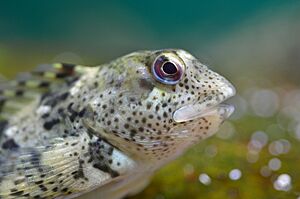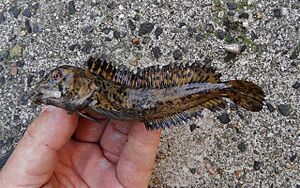Shanny facts for kids
Quick facts for kids Shanny |
|
|---|---|
 |
|
 |
|
| Conservation status | |
| Scientific classification | |
| Synonyms | |
|
The shanny (scientific name: Lipophrys pholis) is a type of fish known as a combtooth blenny. It's also called the smooth blenny or common blenny. This fish grows up and can have babies when it is about two years old.
You can find shannies in the eastern Atlantic Ocean, from southern Norway all the way down to Morocco and Madeira. They also live in the Mediterranean Sea, including the Balearic Islands. Shannies mostly eat small crustaceans, like tiny crabs or shrimp. They also munch on other small animals without backbones (called invertebrates) and some plants.
Contents
What Does a Shanny Look Like?
A shanny has a long, slender body, and it can grow up to about 16 centimeters (about 6 inches) long. It has the typical shape of a blenny fish. This means it has a rather large, blunt head with big eyes placed high up. As shannies get older, they grow a soft, fleshy ridge on their forehead.
Their main color is brownish, with green or yellow spots. They also have dark spots arranged in 5 to 6 vertical stripes along their body. There's usually one big black spot near the start of their dorsal fin (the fin on their back). The shanny's color can change to match its surroundings. Some might be blotchy, dark brown, or even blackish.
During breeding season, male shannies change color. They become completely black with a bright white mouth and a light blue edge on their dorsal fin.
Where Do Shannies Live?
Shannies are found in a wide area of the north-eastern Atlantic Ocean and the western Mediterranean Sea. Their home range stretches from Norway down to Morocco and Madeira. They also live in the Mediterranean Sea, going as far east as the Balearic Islands. Shannies are very common around the coasts of Britain and Ireland.
Shanny Habitat and Daily Life
The shanny is a type of fish that lives in the intertidal zone. This is the area along the coast that is covered by water at high tide and exposed to air at low tide. Shannies like rocky coasts in shallow waters. They often show "homing behavior," meaning they like to return to the same spot.
These fish can actually stay out of the water! They hide under rocks or seaweed when the tide goes out. At high tide, they are usually active during the day. When the tide goes out and they are exposed, they can breathe air. They prefer to stay in rockpools when the tide is low. If they can't get back to their favorite pool, they will hide in cracks or under bigger rocks.
Their diet includes small animals that live on the seabed, especially snails, barnacles, and tiny shrimp-like creatures called amphipods. They also eat some algae (seaweed). Less common foods in their diet include small crabs, polychaete worms, isopods, copepods, limpets, mussels, and other small molluscs.
Shanny Reproduction and Life Cycle
Shannies lay eggs. The female lays eggs that are about 1.5 millimeters (a little over 1/16 of an inch) wide. These eggs sink to the bottom and stick to rocks or other surfaces.
Shannies usually lay their eggs during the warmer months, from April to August. The male and female fish mate in pairs. A male shanny will mate with several females and then guard all of their eggs. Each female can lay eggs three times in one season. The eggs are laid under rocks in the intertidal zone. Young shannies, called larvae, can often be seen along the shorelines in the autumn.
Images for kids




